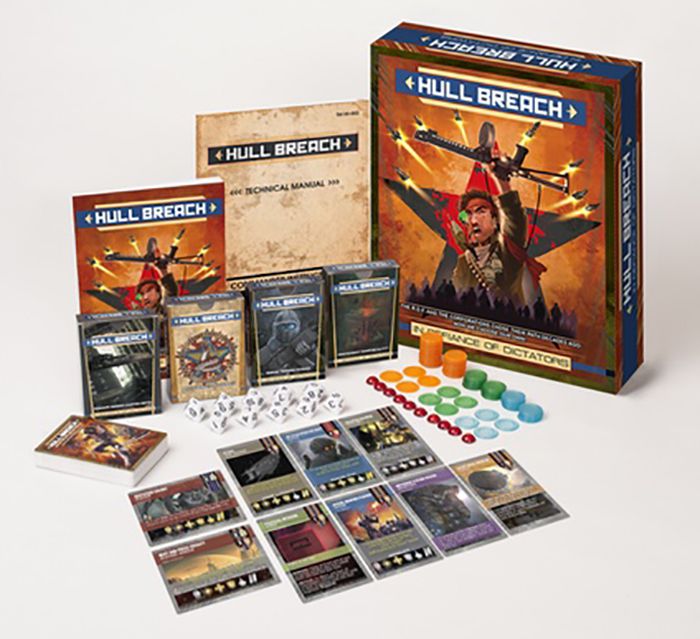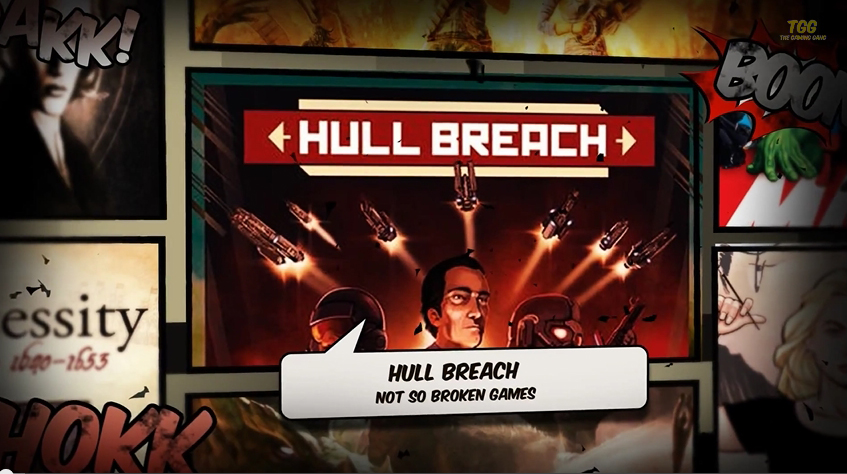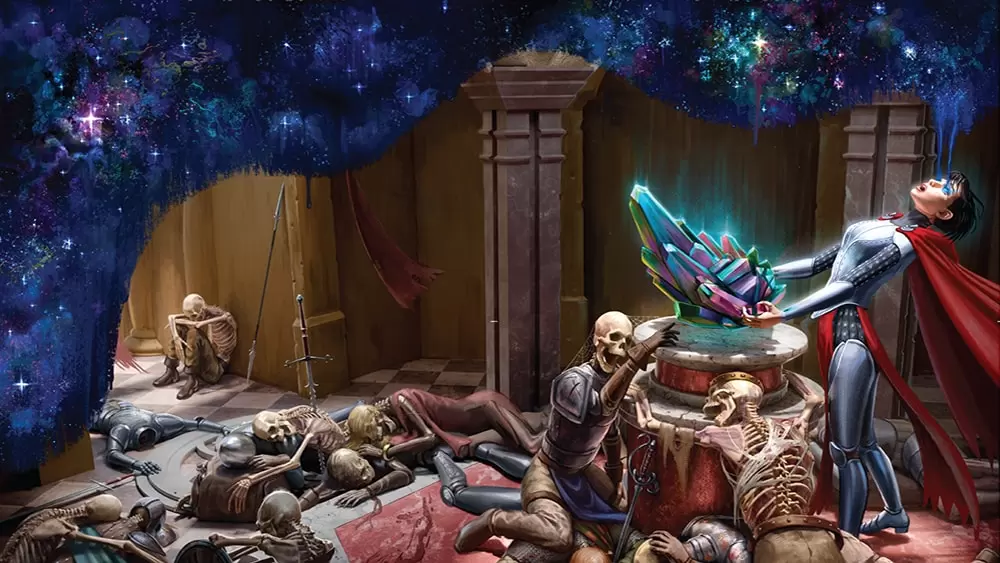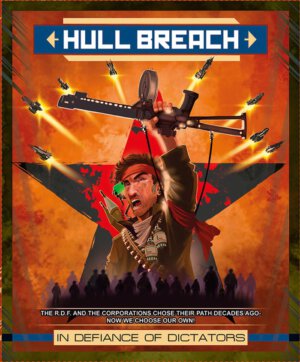
Publisher: Not So Broken Games
Designers: Daniel Auxier
Artists: Tim Greenan, James Hill, and Irvin Jackson
Year: 2016
Genre: Card drafting, dice chucking science fiction game of starship battles
Players: Two to four players
Ages: 12+ (My opinion)
Playing Time: Around 30 to 60 minutes depending on number of players
MSRP: $49.95
Folks may recall I reviewed Hull Breach – Loyalty & Vigilance a few years back and, while I enjoyed the fleet building and slam dunk space combat of the game, the title was missing just a little extra something and final polish to push it into the realm of must haves for science fiction gaming fans. Recently Not So Broken Games successfully Kickstarted another entry into the series and Hull Breach – In Defiance of Dictators is now making its way into your FLGS. Let’s take a look at what’s new.
Hull Breach – In Defiance of Dictators (or HBIDoD mainly from here on out) adds four new faction decks into the mix: The Republic Defense Force (R.D.F.) Marine Training Division, the R.D.F. Merchant Marine Logistics Center, the rebel Rattlesnake Confederacy, and the Independent Shipping Outfit. This brings the total of available faction decks to ten overall and each deck plays quite a bit differently as two new victory conditions have also been added to the game. You can also tweak your decks a bit if you’re aiming for a touch more customization.
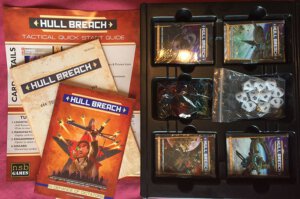
The core mechanics of the game really haven’t changed from previous releases so rather than completely rehash in great detail how turns break down feel free to check out our Origins sneak peek or Hull Breach – Loyalty & Vigilance review videos. Suffice to say players will begin a game by deploying a space station as well as modules for their station. Each station is unique and provides a benefit for that faction. As an example, your station may increase the size of you card hand to six as opposed the usual limit of five. Modules work in the same way and normally provide starting resource and currency production. You’ll need resources and cash to begin to assemble your fleets and continue adding bigger and badder ships and marines to your war machine.
A quick breakdown of each turn is as follows:
Logistics – Simply add your resources and currency earned for the turn to your unused total. Also draw up to your maximum hand size. If your deck (known as the Shipyard) is empty you’ll have to make due with what you have in hand. You can also remove a single damage token from each of your cards or remove all damage if the card contains the “repair” trait. Trade actions may be taken and trade events may be played.
Manufacturing – Spend those aforementioned resources and cash to deploy cards from your hand. Nearly all ships, Marines, upgrades, modules, or option cards have a cost to put them in play. You may also play any research and development breakthroughs and resolve manufacturing event cards. You can also reassign Marines, fighters, and drones to another legal host card.
Engagement – This is the meat and potatoes of any game of Hull Breach and I’ll get into more detail about combat in a bit. Suffice to say this is where you choose who to attack and with what forces.
Discard – Simply discard any cards you wish into the scrapyard (discard pile) keeping in mind you don’t reshuffle discards to start a new Shipyard deck at any point later. Normally, discards are out of play for the rest of the game.
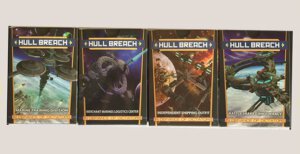
The big selling point of any of the Hull Breach titles is in the combat or, I should say, engagement phase of the turn. This is where fleets slug it out and Marines perform boarding actions. The combat in HBIDoD has a very tasty miniatures game flavor. Each ship card will display attack and defense factors; number of hits it may take; the capacity to carry Marines, fighters, or drones as well as the maximum number of each; initiative; any special ability known as a trait. Ships act in initiative order (unless they possess the “raider” or “interceptor” trait) from lowest to highest. If ships from both sides have the same initiative rating then the attacker rolls first. Simply enough, the attacker declares the target(s) of the attack and rolls a number of ten sided dice equal to ship’s attack value. To score hits, each die must be equal to or higher than the defense value of the target. If the target takes hits equal to its wounds then the ship is destroyed.
Of course there’s more to combat than simply chucking a bunch of dice, while consulting attack and defense factors, and that’s where the ship traits come into play. There are fifteen traits, some active and some passive, ranging anywhere from dealing additional hits to canceling boarding actions to firing off one last volley at an enemy when the ship is destroyed. These traits add quite a few wrinkles to combat and a clever player will do their best to construct fleets where ships compliment each other and their traits.
During the engagement phase players may also attempt boarding actions with ships carrying Marines. This is it’s own separate sub-phase as Marines can hijack or scuttle enemy ships. Get ready for a lot of whooping and hollering the first time your Marines take over your enemy’s big bad flagship!
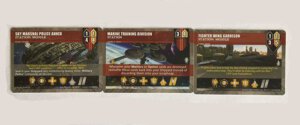
HBIDoD also introduces two new optional, if somewhat anti-climactic, victory conditions to the game: Diplomatic Victory and Economic Victory. Players can earn diplomatic points by sending freighters off on missions and rolling against a target number. Each pip on the die over the target scores a diplomacy point and earning forty points will score you a victory at the beginning of your next turn. Economic victory is achieved by transferring resources and currency (no more than four of each every turn) to bank away twenty of each. Once again, you score the win on the beginning of your next turn.
While the new victory conditions may not be the most thrilling around, and most players will opt for the more exciting conquest type of approach, it’s nice to see Not So Broken Games add options which don’t equate to having to blow up or capture your opponent(s) space station every time out. Plus the new conditions tend to force the more militarily focused factions to do more than just sitting back to build a killer fleet for a one time, all-or-nothing battle.
One aspect of the Hull Breach titles I appreciate is the fact the games never seems to overstay their welcome; players only run through their decks once so there’s a finite supply of ships you can bring into the fight. Most two player games can be completed in around a half hour or so once you have the rules under your belt. HBIDoD does scale well with more than two player but, obviously, look for the game time to increase for every other commander you add to the mix. If you’re learning the game for the first time, I certainly recommend just sitting down with a single opponent. The rules don’t change drastically with more players but you might find the learning experience a bit of a slog if you jump right into a four player game.
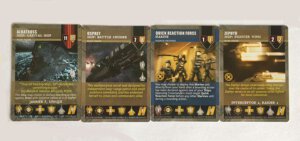
Something I’ve heard has been in the pipeline for Hull Breach over the past few years is the possibility of a campaign game. I’d surely welcome that addition since, truth be told, most of the time victory is achieved by way of destroying/capturing a space station. While the space battles are a blast, more times than not a game ends by seeing a station “Blow’d up real good!” I’d love to see a campaign where fleets occupied various planets or systems in a galaxy. Maybe your faction would score victory points each turn by controlling said planets, or such, and your opponent would need to send ships to wrest control away from you. Personally, I think it would be pretty easy to pull off although you might have to allow for a single refresh of the shipyard during the game.
Yet, this is a review of what HBIDoD is – not what it could become. I dig the game and the SF miniatures-like space battles. Granted, many times you’ll be at the mercy of the fickle dice gods but I like that in my games. If you’re the sort who enjoys a game full of starships of every make and size slugging it out, and rolling honking handfuls of dice, then Hull Breach – In Defiance of Dictators will surely be right up your space lane.
[rwp-review id=”0″]



